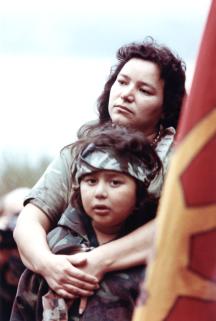My Name Is Kahentiiosta
|
Canada, 1995 (documentaire, 30 minutes, couleurs, anglais)
|
|
Autre titre :
« Je m'appelle Kahentiiosta »
|

|
| Image : © Office national du film du Canada |
Description du film :
« Kahentiiosta était à Kanehsatake, du début à la fin de la crise. Le film décrit ce qu'elle y a vécu, puis surtout sa comparution au tribunal parce que le Procureur général n'acceptait pas son nom mohawk et enfin sa vie et celle d'autres 'warriors' au camp militaire de Farnham. »
-- Office national du film du Canada
(source)
|
| Générique (partiel) : |
| Scénario : | Alanis Obomsawin |
| Produit par : |
Alanis Obomsawin, Don Haig |
| Montage images : |
Ruby-Marie Dennis |
| Musique : |
Claude Vendette, Francis Grandmont |
| Société de production : |
National Film Board of Canada / Office national du film du Canada |
(sources)
Citations sur My Name Is Kahentiiosta [en anglais]
« In the early days of the [Oka] Crisis, [Alanis] Obomsawin abandoned the project she was working on in order to take a film crew to Kanesatake. Obomsawin remained behind the barricades for the duration of the Crisis, providing the only First Nations-generated footage of this event. The insight she brings, as a Native person, to the Crisis is key to its chronicling and to mediating the experiences of the Mohawk people in the community. Her work fulfills an important archival and communicative function. From the footage she collected over those many weeks, [in addition to Kanehsatake: 270 Years of Resistance] Obomsawin also made My Name is Kahentiiosta (1995), about a Mohawk woman's arrest and defiance after the Crisis; Spudwrench: Kahnawake Man (1997), the story of a Mohawk ironworker involved in the defense of Kanesatake during the Crisis; and Rocks at Whiskey Trench (2000), in which she explores corollary events at another nearby Mohawk community, the reservation of Kahnawake. In all of these films, she deftly weaves Mohawk culture, the politics of community, the history of Native/non-native relations and the experience of trauma with a unique lens on setting, the land itself. »
-- Elizabeth Claire Kalbfleisch
(source)
« The filmic strategy [of My Name Is Kahentiiosta] invites the spectator into the subject's world. It's not quite clear whom Kahentiiosta is addressing; she could be telling what happened to people in her community who were not there or had not heard about it. The narration is very informal and conveys powerfully if in tactfully restrained manner the pain of the violence threatened to land that contains memories of ancestors and represents links to the earth vital to the community. »
-- E. Ann Kaplan
(source)
« Unlike Kahnesatake, My Name is Kahentiiosta (1995) is a memoir rather than a history of the standoff, with one Mohawk woman providing a microcosm of the event and its aftermath. In traditional Mohawk fashion, Kahentiiosta begins the twenty-nine-minute film with a recounting of her birth and family history, before emphasizing the impact of the Oka crisis on her children. »
-- Randolph Lewis
(source)
Bibliographie sur My Name Is Kahentiiosta
Brèves parties de livres
-
KAPLAN, E. Ann. Trauma Culture: The Politics of Terror and Loss in Media and Literature, New Brunswick, NJ, Rutgers University Press, 2005.
[en anglais] (pp. 116-121)
-
LEWIS, Randolph. Alanis Obomsawin: The Vision of a Native Filmmaker, Lincoln, University of Nebraska Press, 2006, American Indian Lives.
[en anglais] (pp. 110-112)
Sites Web sur My Name Is Kahentiiosta


